 CLOUD
CLOUD
 CLOUD
CLOUD

 CLOUD
CLOUD
Over the past decade, Cloudflare Inc. has built a global network that has the potential to become the fourth U.S.-based hyperscale-class cloud.
In our view, the company is building a durable revenue model with hooks into many important markets. These include the more mature distributed-denial-of-service protection segment, but also extend to growth sectors such as zero-trust security, a serverless platform for application development, and an increasing number of services such as database and object storage.
In essence, Cloudflare can be thought of as a giant, distributed supercomputer that can connect multiple clouds and act as a highly efficient scheduling engine – allocating and optimizing resources at large scale. Its disruptive DNA is increasingly attracting novel startups and established global firms looking for a reliable, secure, high-performance, low-latency and more cost-effective alternative to Amazon Web Services Inc. and legacy infrastructure solutions.
In this Breaking Analysis, we initiate deeper coverage of Cloudflare. Although the stock got hammered this past week on tepid guidance, we are optimistic about the company’s future. In this post, we’ll briefly explain our take on the company and its unique business model. We’ll then share some peer comparisons with both a financial snapshot and some fresh Enterprise Technology Research survey data. Finally, we’ll show some examples of how we think Cloudflare could be a disruptive force with a supercloud-like offering that, in many respects, is what multicloud should have been.
Cloudflare has been on the periphery of our radar. Ben Thompson and some others have written about the company’s disruptive business model. And recently a Breaking Analysis follower, who will remain anonymous, emailed with some excellent insights on Cloudflare with customer feedback that prompted us to initiate more detailed coverage.
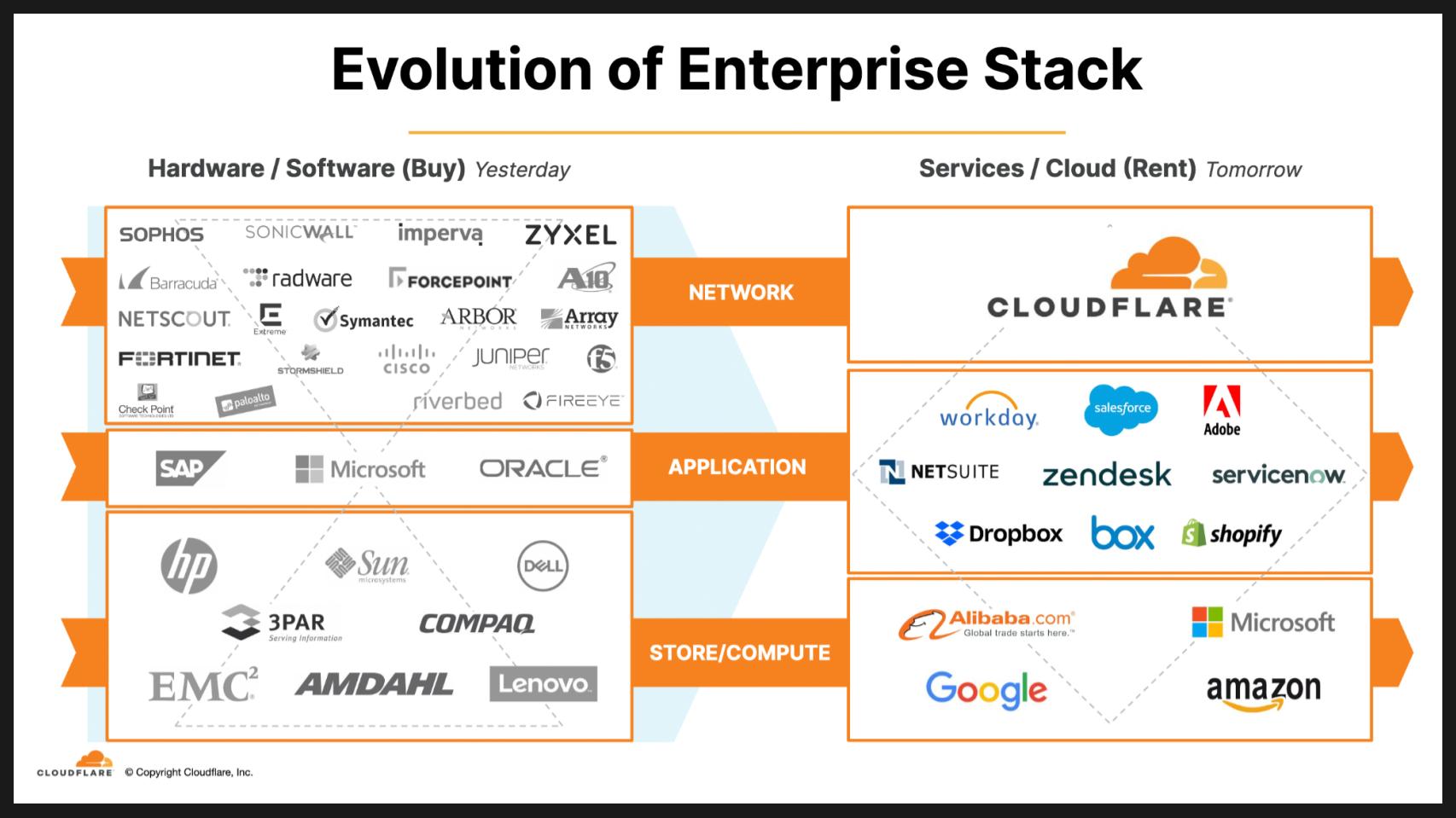
Let’s first take a look at how Cloudflare sees the world in terms of the modern cloud stack. The graphic above shows a simple three-layer stack comprising storage and compute infrastructure, an application layer and the network. The key message is that the Big Four hyperscalers have replaced the on-premises leaders, apps have been transformed with software as a service, and that mess of network switching, routing, visibility and firewalling can now all be handled by Cloudflare. And of course the stack can be rented via operating expense versus requiring heavy capital investments.
Granted, this is a simplified view of what all those companies on the left are doing. They’re not standing still and we’ll come back to that. But Cloudflare has done something quite remarkable.

It has been a while since we’ve invoked Russ Hanneman of HBO’s “Silicon Valley” fame on Breaking Analysis. But remember the scene where Richard Hendricks, the whiz kid on the show – desperate for funding – tracks down Hanneman to ask for cash? And Hanneman realizes Richard isn’t passionate about the idea he’s pitching and says to Richard, something like: “If you had unlimited time and resources, what would you build with your compression algorithm? 3-2-1 go!”
And Richard stutters a response: “A new internet.” That conversation led to Pied Piper, a peer-to-peer network powered by decentralized devices and a magic compression algorithm that enabled high-speed data movement and low-latency access to data.
In a way that’s what Cloudflare has built. Its founding premise reimagined how the internet should be built — with a consistent set of servers, placed around the world, where each server had lots of cores, lots of DRAM memory, lots of cache, fast solid-state drives, and plenty of network connectivity and bandwidth. The picture below represents those points of presence Cloudflare has built.
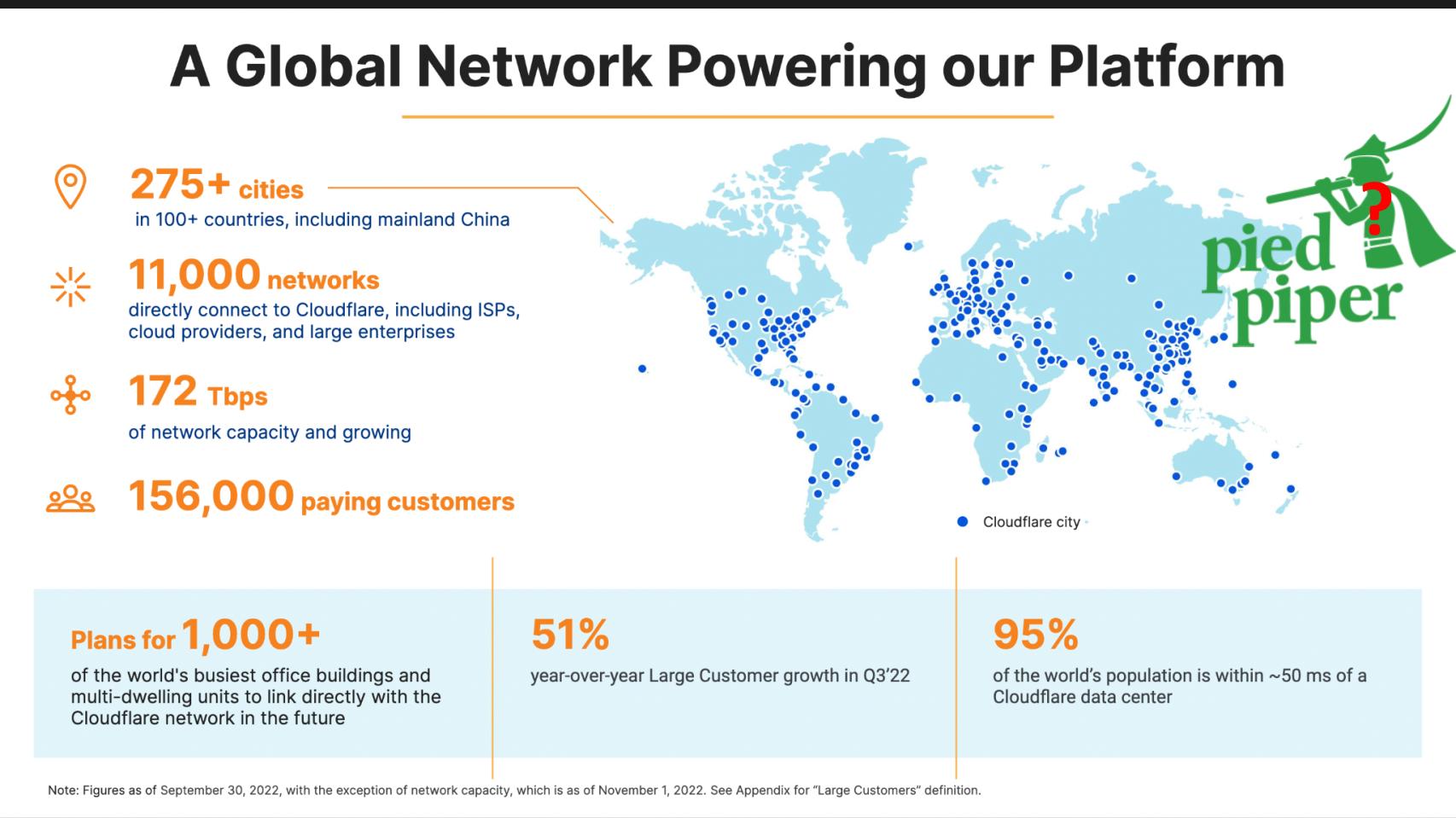
Now it looks like a bunch of points on a map – which it is – but there’s a software layer that enables Cloudflare to observe and manage these resources as a single massive distributed system, efficiently invoking and allocating resources across this global network.
The company claims that its network utilization is in the 70% range. It has used its buildout to enter the technology space from the bottom up, offering free tiers of services to users. Users have many entry points into the network via a variety of services. Once they’re on board, Cloudflare keeps selling more services over time to a customer, which drives up average contract amounts and lifetime value. At the same time, the company continues to innovate and add new services at a rapid pace.
You can think of Cloudflare’s initial market entry like a lightweight Cisco-as-a-service. The company’s chief financial officer actually calls it that, which really must tick off Cisco Systems Inc., which has a massive portfolio and dominant market position.
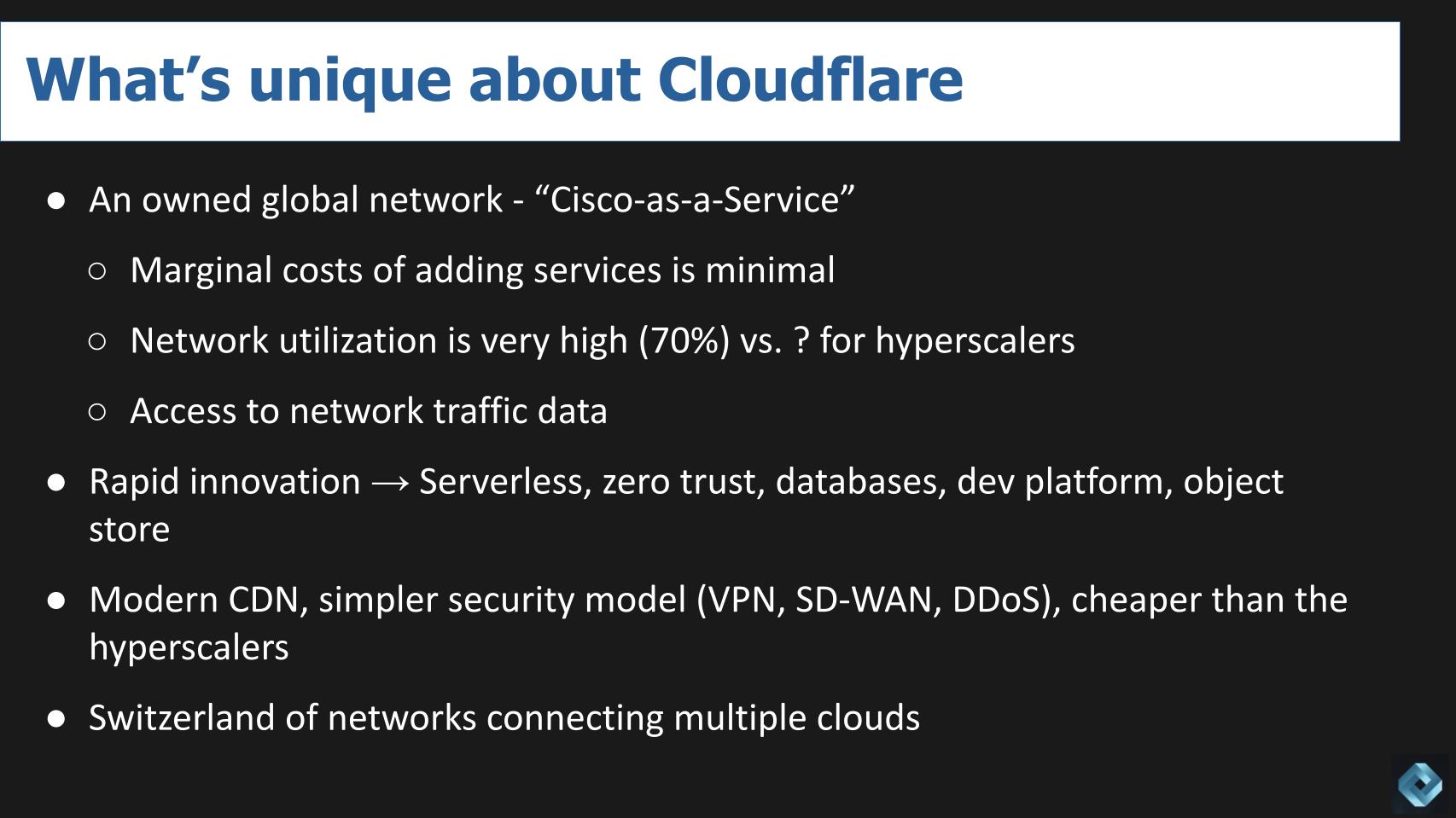
Because it owns the network, the marginal cost of adding new services is very small and goes toward zero. So it’s able to get software-like economics at large scale without the constantly increasing infrastructure tax faced by SaaS companies.
Snowflake Inc., for example, doesn’t own its own network infrastructure. It relies on AWS or Microsoft Corp.’s Azure or GCP. And although that gives the company obvious advantages, it also forces Snowflake to find operating leverage in other parts of its business. It also requires it to negotiate constantly with hyperscalers for better rental rates on cloud infrastructure.
As previously mentioned, Cloudflare claims its utilization is very high — probably higher than hyperscaler cloud providers, which spin up servers and can charge for underutilized customer capacity.
The company also has mounds of network traffic data and can use that data to its advantage. The company has been rapidly innovating beyond its original core business adding serverless, a development platform, zero-trust offerings, a database called D1. It has also announced an object store called R2 – that’s S3 minus one, that is, minus the egress costs AWS charges for its database service. It has promised a D2 database – of course R2D2.
Cloudflare can be thought of as a modern content distribution network with a simpler security model that brings virtual private network, software-defined wide-area network and DDoS protection capabilities in a single network package, with an economic model that is less expensive than AWS and other hyperscalers.
Moreover, Cloudflare has begin positioning itself as a neutral network that can connect multiple clouds and has caught our attention as an enabler of supercloud.
To be clear, unlike AWS in particular, Cloudflare is not highly diversified, at least not today. It’s not well-suited, for example, to lift and shift your traditional information technology apps such as SAP HANA and run it on its platform. Rather, the company started out by making websites more secure and faster. It flew under the radar. It’s much in the same way that Clay Christensen described the disruption in the steel industry, where new entrants picked off the low-margin rebar business, then moved up the stack, Cloudflare is running a similar playbook in the cloud. It’s viewed as commodity while the likes of AWS and Akamai are viewed as higher-value providers.
And that’s often how many, if not most, disruptions start.
In the early part of last decade, as AWS’ ascendency was becoming more clear, many of us started thinking about how and where firms could add value as AWS became so dominant. Taking an industry focus, data sharing, building on top of clouds, building private and hybrid clouds… but not many had the wherewithal or the chutzpah to build out a global network that could serve as the connecting platform for cloud services.
Despite the recent hit on its stock, Cloudflare has traction in the market. As it adds new services such as zero trust and object store and database, its total addressable market continues to grow. And it is just getting started. Having a global network asset such as what Cloudflare has built gives it lots of optionality to continue TAM expansion.
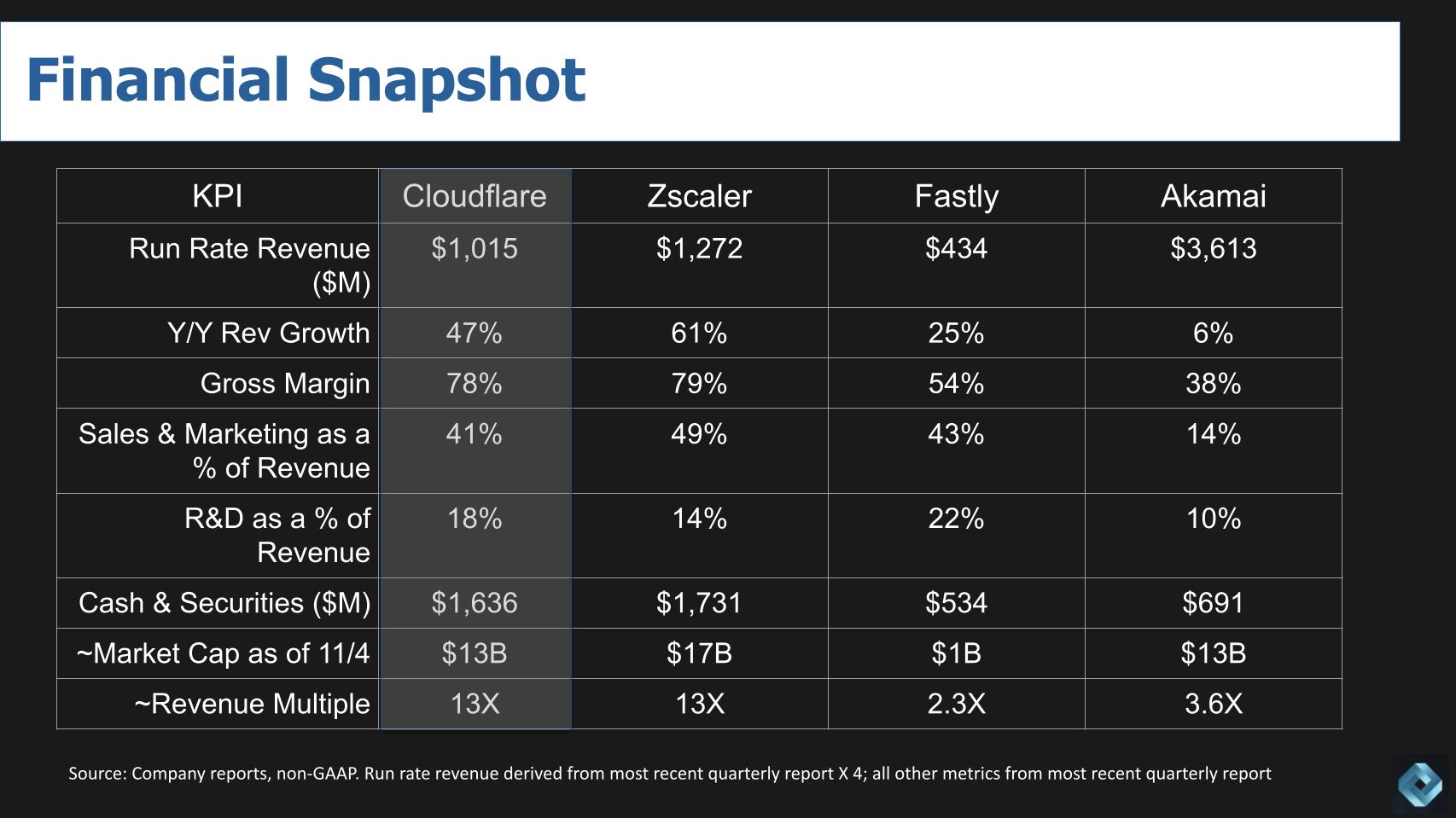
Above is a quick snapshot of Cloudflare’s financials relative to Zscaler Inc., a competitor and customer, Fastly Inc., a smaller CDN, and Akamai Technologies Inc., a more mature edge platform and CDN player. Cloudflare and Fastly both reported earnings this past week. Cloudflare surpassed a $1 billion revenue run rate, gave tepid guidance and the stock got crushed on Friday. But the company’s business model is sound. It’s growing close to 50% annually, it has SaaS-like gross margins in the mid- to high 70% range, a strong balance sheet and a 13-times revenue run rate multiple.
In fact, its financial snapshot is quite close to that of Zscaler, which of course doesn’t own its own network – it’s a pure-play software company. Fastly is much smaller and yet is growing more slowly than Cloudflare, hence its significantly cheaper multiple. Akamai, as you can see, is a more mature company with a nice business. But it’s valuation is the same as Cloudflare’s despite having 3.6 times the revenue.
On its earnings call this week, Cloudflare announced that its head of sales was stepping down and the company has brought in a new leader to take the firm to $5 billion in sales. The company is promising to be free cash flow positive by the end of year and is working toward its long-term financial model with gross margin in the mid-70s and 20% non-GAAP operating margins. To our knowledge it hasn’t committed to a long-term growth rate, but it would likely be in the 20%-plus range at least in order to continue to command a premium valuation.

Enterprise Technology Research is very positive on Cloudflare and has published a recent report on the company. Like many firms, Cloudflare is seeing an across-the-board slowdown in spending velocity. In the data we see that many customers are shifting spend to flat from growth… or in the market shifting from paid to free tiers for a period of time. But we’re seeing some larger customers actually spending more, which was confirmed on Cloudflare’s earnings call. And its churn is very low.
Let’s dig into the ETR survey data. Above we show a two-dimensional graphic, with Net Score or spending momentum on the vertical axis and Overlap or pervasiveness in the survey on the horizontal axis. The data cut we’re showing focuses on three segments in the ETR taxonomy – cloud, security and networking.
The table inserted in the upper left shows the raw data, which informs the position of each company with Net Score and the N’s listed in the columns. The red dotted line at 40% indicates a highly elevated Net Score. And finally we’ve posted the breakdown of Cloudflare’s Net Score in the bottom right of the chart. The lime green is new adoptions, the forest green is spending more, the gray is flat, the pinkish bar is spending less and the bright red is churn, which at 1% is a very good indicator of strength.
Subtract the reds from the greens and you get a Net Score of 39%… just under the magic elevated line.
Note that, much like the financial snapshot we showed, Cloudflare and Zscaler are right on top of each other. Cisco has a dominant position on the X axis that Cloudflare and others are eyeing to disrupt. AWS also is dominant, but note that its Net Score is well above the red dotted line — incredible given its size. Palo Alto Networks Inc. is also very impressive, with both a strong presence and a Net Score comparable to Cloudflare and Zscaler.
Akamai is actually well-positioned for a reasonably mature company and you can see Fastly, AT&T Inc., Juniper Networks Inc. and F5 Inc. have far less momentum than Cloudflare but at least are in positive Net Score territory.
So it will be interesting to see is whether Cloudflare can continue to hold this momentum or even accelerate as it scales out its network and keeps adding services.
Cloudflare has a couple of potential strategic vectors and we believe the market will dictate the direction the company ultimately takes. They’re not mutually exclusive, but we think opportunities in multicloud/supercloud will emerge that could be enticing to Cloudflare, notwithstanding that there exist dependencies that will affect that possible outcome.
One path, which it is clearly on today, is to compete more directly as a cloud play, offering secure access edge services such as firewall as a service, zero-trust services such as data loss prevention, and email security from its Area 1 acquisition, as well as other zero trust offerings. It also offers other network services such as routing, network connectivity, load balancing and many other services, including object storage and database services. In the future we think, Cloudflare is well-positioned to offer more edge services, including telecommunications services such as network switching. So that’s one route, and Cloudflare is on that path today and continue to mine opportunities there.
The other opportunity is what we call supercloud as an enabler of cross-cloud infrastructure. The title of this episode is what multicloud should have been — meaning Cloudflare could be the control plane providing a consistent experience across clouds, one that is fast and secure at global scale.
Cloudflare Chief Executive Matthew Prince and other Cloudflare managers studied under Clay Christiansen and lean heavily toward disruptive business models. To give you insight on how Cloudflare thinks about its business options, take a look at some of the comments made by Prince.

Cloudflare put its R2 object store into public beta this past May and we believe is storing around a petabyte of data today. Here’s what Prince said about that:
We are talking to very large companies about moving more and more of their stored objects to where we can store that with R2. And one of the benefits is not only can we help them save money on the egress fees, but it allows them to then use those objects across any of the different cloud platforms they’re using. So by being that neutral third party, we can let people adopt a little bit of Amazon, a little bit of Microsoft, a little bit of Google, a little bit of SaaS vendors, and share that data across all of those different places.
So what’s interesting about this in the supercloud context is it suggests that customers could take the best of each cloud to power their digital businesses. A customer might like AWS for RedShift and Google’s machine learning and Microsoft’s collaboration, and they’d like a consistent way to connect and secure those resources. But of course Prince strongly hints that AWS’ egress fees are a blocker to that vision.
At a recent investor event Prince added some color to this concept when he talked about one metric of success being how much R2 capacity was consumed. But perhaps a more interesting benchmark is highlighted by the following statement he made:
A completely different measure of success [for R2] is Andy Jassy says, “I’m sick & tired of these guys [Cloudflare] taking our objects away…we’re dropping our egress fees to $0.” I would be so excited because we’ve then unlocked the ability to be the network that interconnects the cloud together.
And that, of course, gets closer to the supercloud value proposition.
To further drive that point home (we’re paraphrasing his comments here), Prince said:
Customers need one consistent control plane across clouds… and we are the neutral network that can be consistent no matter which cloud you’re using.
Interesting, right? Prince sees the world that’s similar to, if not nearly identical, to the concepts that theCUBE community has been putting forth around supercloud.
Cloudflare has much work ahead. The IT slowdown will hit it, like most every tech firm. Prince even suggested that his initial vision of an application running across multiple clouds (that is, supercloud nirvana) isn’t what customers are doing today. That’s really hard to do and perhaps may never happen.
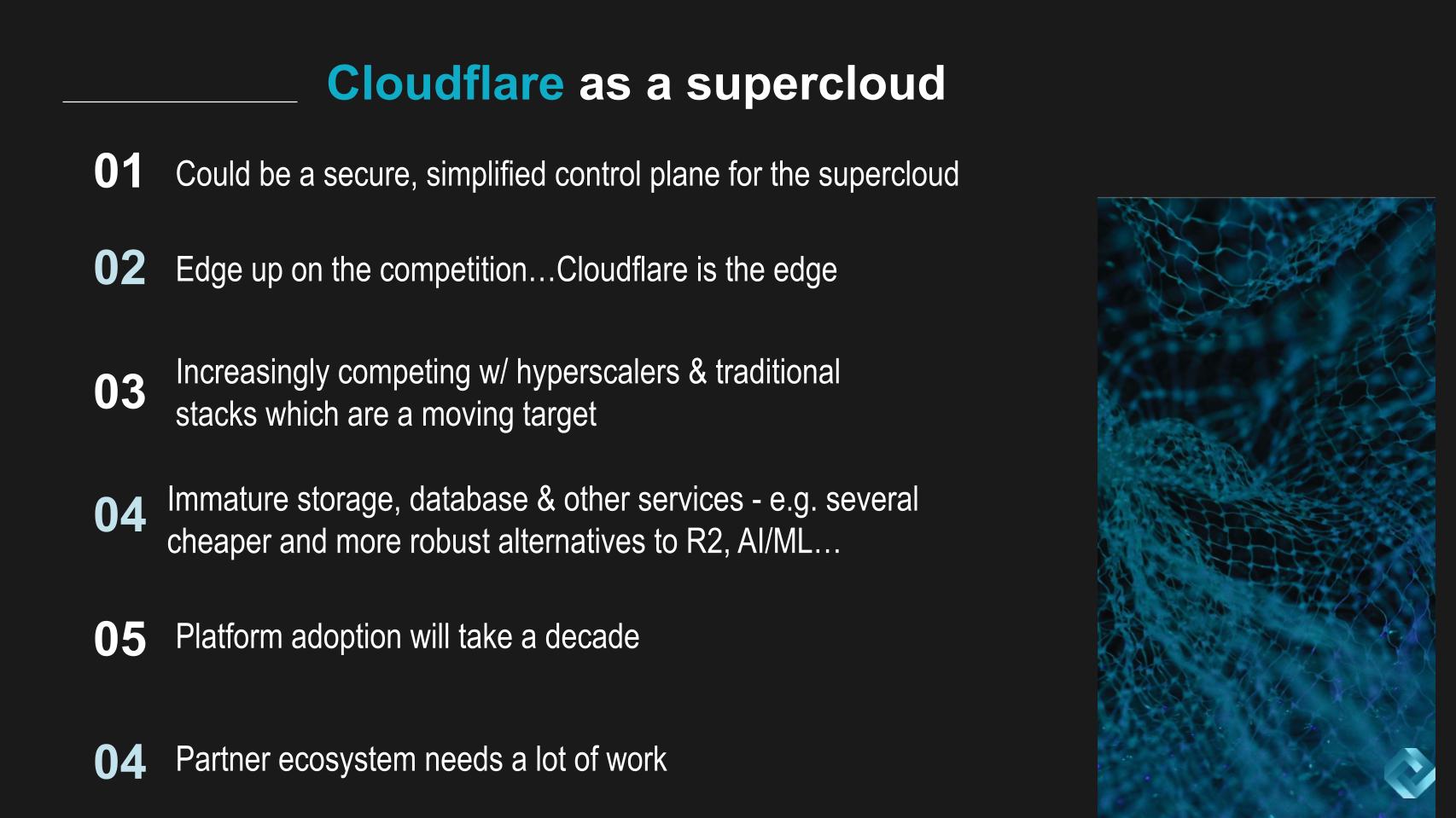
But there’s little doubt that Cloudflare could be, and is positioning itself to become, a cross-cloud control plane. It has the network economics and the business model levers to pull.
It has got an edge up on the competition at the edge – pun intended. Cloudflare is the very definition of edge. And its distributed platform is much better-suited for edge workloads than giant data centers are set up to handle today.
Cloudflare is increasingly competitive to the hyperscalers and those traditional stacks that it depositioned on the earlier slide we showed. But you know the likes of AWS, Dell Technologies Inc., Hewlett Packard Enterprise Co., Cisco and others aren’t sitting still. They have huge customer bases and are a constantly moving target… albeit not fast-moving.
As well, let’s face it: It takes a decade to get enterprises to adopt a database or a developer platform. Cloudflare’s capabilities when compared with incumbent stacks and the hyperscalers is much less diverse and less robust in these areas. Even in storage, despite all the great conversation that R2 generated, specialists such as Wasabi are more mature, more functional and even actually cheaper than Cloudflare. So it’s not a fait accompli that Cloudflare will win those markets.
If Cloudflare wants to be the fourth U.S.-based hyperscaler or create the Big Five if we put Alibaba in the mix, it has a lot of work to do in the ecosystem. By its own admission, it has much to learn there and is part of the value it sees in Area 1, its email security acquisition. But even in that case, much of the emphasis is on reseller channels. Compare that with the AWS ecosystem, which is not only a channel play but as much an innovation flywheel where companies such as Snowflake, MongoDB Inc. and others are winning side-by-side with AWS’ data stores.
In addition, all the on-prem stacks are building hybrid connections to AWS and other clouds as a means of providing consistent experiences across clouds. Very few companies are not eyeing this opportunity, including strong firms such as NetApp Inc., Pure Storage Inc., Dell, HPE, Qumulo Inc. and dozens of others.
But we’ll close with this: Cloudflare is one of those companies that is in a position to wake up each morning and ask, “Who can we disrupt today?” Very few companies are in a position to disrupt the hyperscalers to the degree that Cloudflare is. And that, friends, will be fascinating to watch unfold.
Alex Myerson and Ken Shiffman are on production, podcasts and media workflows for Breaking Analysis. Special thanks to Kristen Martin and Cheryl Knight who help us keep our community informed and get the word out, and to Rob Hof, our editor in chief at SiliconANGLE.
Remember we publish each week on Wikibon and SiliconANGLE. These episodes are all available as podcasts wherever you listen.
Email david.vellante@siliconangle.com, DM @dvellante on Twitter and comment on our LinkedIn posts.
Also, check out this ETR Tutorial we created, which explains the spending methodology in more detail. Note: ETR is a separate company from Wikibon and SiliconANGLE. If you would like to cite or republish any of the company’s data, or inquire about its services, please contact ETR at legal@etr.ai.
Here’s the full video analysis:
All statements made regarding companies or securities are strictly beliefs, points of view and opinions held by SiliconANGLE Media, Enterprise Technology Research, other guests on theCUBE and guest writers. Such statements are not recommendations by these individuals to buy, sell or hold any security. The content presented does not constitute investment advice and should not be used as the basis for any investment decision. You and only you are responsible for your investment decisions.
Disclosure: Many of the companies cited in Breaking Analysis are sponsors of theCUBE and/or clients of Wikibon. None of these firms or other companies have any editorial control over or advanced viewing of what’s published in Breaking Analysis.
THANK YOU